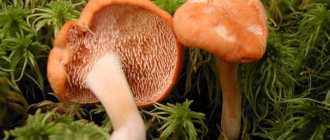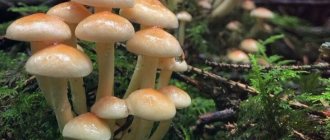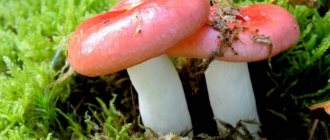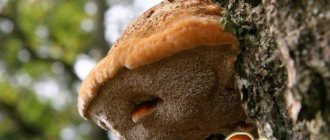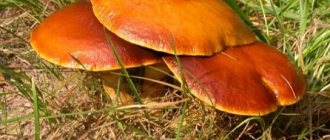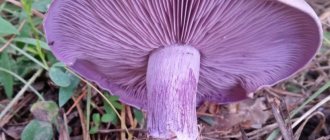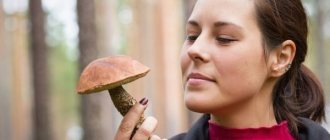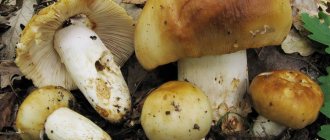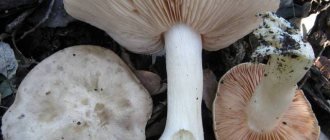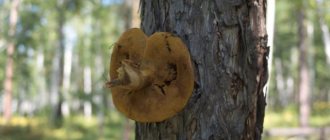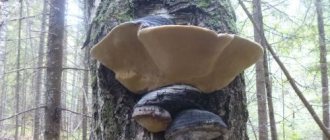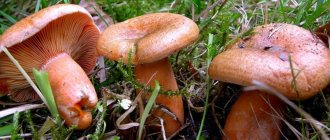Edible boletus is one of the most delicious representatives of the mushroom kingdom. They are in no way inferior to porcini mushrooms either in aroma, taste, or appearance after processing. Everyone will be happy with their “catch”.
But sometimes among them there are false boletus, or more precisely, conditionally edible ones. How to distinguish them from other mushrooms, what should you pay attention to when collecting? First of all, you should remember what edible species there are, and then carefully look at the photos of their counterparts.
False boletus, description of species
Even an oily cap indicating the edibility of a butter dish cannot always be an accurate guarantee of safe consumption. Today, mycologists cite many secondary signs and comparisons that allow even a beginner to understand what false boletus mushrooms are and how to easily distinguish them from the real one, which has value and an amazing mushroom taste.
No. 1 - Kozlyak or Suillus Bovinus
Popularly it has an alternative name - Reshetnik. Belongs to the Boletaceae family. Refers to the tubular variety of Maslenka. From experienced mushroom pickers, you can hear other equally common names for false butterfly: moss mushroom, fireweed, mullein.
It grows in coniferous forest belts with high humidity. More often found at the border of forest and reservoir. It has several subspecies belonging to the category of conventional and edible mushrooms. Allowed for consumption after prolonged heat treatment, which includes: cleaning from contaminants, rinsing under running water, double or triple (optional) boiling with draining of the broth.
It grows in the Central and European parts of Russia and neighboring countries. You can find the fruits: in Siberia and the Urals, the North Caucasus, Ukraine and Belarus, the Far East.
The color scheme may vary depending on the place of germination and subspecies. The shade can range from faded yellow to burgundy.
It is allowed to prepare first and second courses, canned foods and pickles in the winter, provided that the recipe, storage rules and shelf life of the product are followed.
No. 2 – Pepper butterdish or Chalciporus piperatus
Another tubular mushroom, most often colored brown. Belongs to the family Boletaceae or Oilcan (depending on the literary edition). Reproduction is controversial, as it matures.
It grows more often in dry forests of coniferous forests, less often in young plantings of pines and spruces. Fruiting occurs in mid-summer and continues until the first autumn frosts.
Quite often, even experienced mushroom pickers confuse a real butter dish with a pepper one, calmly consuming the product after heat treatment as food. The light peppercorn does not scare cooks at all, mixing with the consistency of other mushrooms.
Many mycologists still disagree about the edibility of the mushroom. Some classify the variety as a conditional type, others say it is inedible due to the peppery aftertaste.
The Pepper butterdish has an additional difference - the absence of a ring on the stem at any age.
Helpful advice!
It is recommended to go searching in coniferous forests, where pine trees predominate. Pepper butterfly more often forms mycorrhiza with these trees than with spruce and cedar.
No. 3 - Siberian oiler or Suillus Sibiricus
Belongs to the Oilcan family, genus Maslenok. In terms of sliminess, it is in no way inferior to the classic version. The outer part of the cap is covered with a thin mucous film that requires removal during heat treatment. Completely edible, despite the dramatic differences in color. Without experience, mushroom pickers often perceive the Siberian mushroom with a cedar oil dish, despite the slight differences.
It grows in old coniferous and mixed forests where cedar trees are planted. Fruiting occurs at the beginning - mid-August, and ends only at the end of September - beginning of October.
The northern regions of Russia and the Far East remain a storehouse of the subspecies. You can most often meet the Siberian Maslyon in Siberia and the Urals, less often in the Leningrad region, which has an unstable climate even in the summer months.
It reproduces by spores as it matures.
It belongs to the category of edible mushrooms of the third class, requiring long-term cleaning and repeated boiling with changing decoction.
No. 4 - Spruce Wetweed or Gomphidius Glutinosus
A mushroom from the Mokrukhov family, it belongs to the edible type of forest products. It is rarely confused with an oil can, despite the presence of a slimy film on the top of the hat. Unlike the real subspecies, instead of a spongy hymenophore, it has a lamellar covering.
The color scheme is often repulsive: brown-violet, bluish, less often dark gray.
The pulp is fragile, reminiscent of russula, difficult to maintain its shape after harvesting.
Fruiting occurs in mid-summer, approximately mid-July. Germination continues for several months, ending towards the end of October. You can meet mushrooms by going in search of edible prey in the coniferous zone, where high humidity prevails.
It reproduces by a dark brown powder secreted by a controversial method.
It is found almost throughout Russia, Ukraine and Belarus.
Important!
In recent years, the literature has increasingly seen the assertion that Mokrukha Spruce is a conditionally edible mushroom that requires careful heat treatment before cooking. Regardless of the recipe, which involves serving the dish for lunch and dinner or preparing it for the winter, the following is necessary: cleaning from forest contaminants and thin film, rinsing under running water, cutting into 4 parts and boiling in several waters. After the first boiling, the mushroom changes color to a darker one, but you shouldn’t be afraid of this. The value, taste and tenderness of the product will not be affected after boiling, but, on the contrary, will improve. If desired, adding spices and herbs to taste is welcome to highlight the bright mushroom taste with additional notes of nature.
Helpful information!
The usefulness of the mushroom in Europe is taught on a par with mushrooms and mushrooms. As a result of this feature, the cost of mushrooms and their ratings among culinary critics are high.
No. 5 - Oiler Sour or Suillus Acidus
The variety discovered by Charles Peck, despite its relationship to edible mushrooms, rarely deserves the attention of lovers of quiet hunting. Based on the name, it has a sour taste that does not arouse further desire to consume the product.
After heat treatment, the taste improves slightly, but cannot be compared to the level of the real variety.
It is quite rare due to its germination in the taiga of Siberia. It has a thinner stem with a ring at the base. According to the pattern, it is comparable to boletus or boletus because of the dark inclusions. The hat is grayish-yellow. At a young age it is rounded towards the base, with age it straightens out.
It is recommended to go in search of the mushroom to a coniferous deposit, rich in old pine trees or clearings. Fruiting lasts from late July to mid-September.
Important!
To easily distinguish false boletus from a photo, you should go fishing at least once with an experienced quiet hunter. His skills will help him clearly remember the signs of similar-looking mushrooms found in his region of residence. If this is not possible, you can view visual videos and literature with similar descriptions and pictures.
Edible and conditionally edible mushrooms similar to boletus
Some mushrooms, quite similar to edible boletus mushrooms, are classified as conditionally edible:
- The larch butterfly lives in symbiosis with deciduous trees. When young, the cap is semicircular and cone-shaped; when mature, it is smooth and pillow-like. The leg is 10 cm high and the same color as the hat. The pulp is dense, fleshy, yellow, and turns brown at the cut site. The taste and aroma are pleasant.
Larch oiler - Kozlyak (latticed grass) grows in places with high humidity under pine trees. Fruits from early July to November, in frequent groups. The cap is red-brown, round, and as it grows it turns into a pillow. It is about 11 cm in diameter. The surface is covered with mucus, smooth and glossy. The skin is easily separated from the pulp. The pulp is fleshy, light with brown tints. It tastes sour. Suitable for pickling.
Kozlyak - Yellowish oiler grows on the sandy soils of Siberia. The mushroom cap is orange-cinnamon in color. The cap is conical and 6 cm in diameter. There is a ring on the stem that resembles white gelatin. When cooking, it is important to carefully remove the skin, which can cause severe diarrhea.
Oiler yellowish - Gray oiler grows in deciduous forests and parks from June to September. The hat is light gray. The leg is 10 cm high, shaped like a cylinder, and has a white ring. The surface is mucous. Turns blue when cut.
Oiler gray - Spruce mokruha belongs to the genus Mokrukha and is a completely edible counterpart. It grows in spruce forests and bears fruit well in summer. The hat can be 12 cm in diameter, gray-violet. The shape is first wavy, then spread and sunken in the center, with edges downward, fleshy and mucous when immature. The color of the spores is almost black. The taste and aroma are pleasant. The pulp is yellow in color.
Spruce weed
Is there any danger when assembling the false oiler?
Any experienced mushroom picker knows that even false boletus is edible and can be eaten after heat treatment. However, beginners should not relax! In coniferous forests, inedible varieties of mushrooms are quite common, which, by accident or lack of care, can end up in the basket. Pale toadstool, fly agarics and other poisonous specimens cause serious poisoning, leading to intoxication and death in the absence of first aid.
In recent years, even forest areas have been subject to pollution due to human faults. As a result of poisoning of the soil and environment, sometimes even the most edible and healthy mushrooms cause gastrointestinal upset and poisoning. To protect yourself and the health of your family and friends, mycologists advise excluding places close to highways, cemeteries, and industrial zones from collecting butter.
Processing mushrooms after harvesting
Butterflies are mushrooms that have a pleasant aroma and taste. But if the heat treatment was carried out incorrectly, this wealth can be lost. How to properly prepare mushrooms for processing? First of all, you need to sort them out, determine the type, and make sure that no poisonous mushroom is in the basket. And only then start cleaning. This must be done immediately as soon as they are brought from the forest. Otherwise, they quickly deteriorate, and insect larvae, comfortably located in the mushrooms, play an important role in this.
The skin is removed, but only from those species where it can be easily separated. Experts believe that consumption with the skin can lead to digestive upset.
But many mushroom pickers, sharing their experience, claim that a mushroom cleaned in this way is more attractive than a specimen with a dark cap.
After the mushrooms are cleaned and sorted, you need to rinse thoroughly several times. It is best to fill the butter with cold water. This will preserve their smell. Then chop the mushrooms and rinse again. Be sure to let the water drain. Do not soak the fruiting bodies for a long time. They absorb water like a sponge, and then they are difficult to clean, cut, and their taste after this leaves much to be desired. Then you can proceed to heat treatment or other harvesting methods.
Butterflies are almost universal mushrooms. They can be dried, fried, boiled, cooked in soups and caviar, pickled and salted.
Contraindications for use
After studying the false oiler photo and description of the mushroom, it is worth weighing all the pros and cons of collecting the product. For example, it is not recommended to collect peppery and sour because of the bright aftertaste, which is not always suitable for most mushroom pickers. Other options for collection are allowed provided there are no health contraindications. Leading doctors advise people suffering from chronic heart and vascular diseases, kidney failure, gastrointestinal disorders, and diabetes to avoid eating any mushrooms. Consumption is prohibited: for children under 13 years of age, women during lactation and pregnant women.
Real and false boletus is a heavy food that is difficult to digest. To make the process easier, you should prefer light, steamed dishes to fried foods. Wash down the mushroom recipe, preferably with warm drinks: herbal or black tea. If you feel heaviness in your stomach, you can drink lemon water in a small amount.
Another contraindication for use is an allergic reaction and individual intolerance to the product. If redness, itching and swelling occur, you should immediately call an ambulance to provide first aid to prevent angioedema.
Places of growth
The oiler is ordinary - traditional for Russian areas. It is found more often in deciduous forests and pine forests, and also in plantings among heather and cereals.
Boletus also grows in Africa and Australia (wherever the climate is close to temperate). False mushrooms accompany their edible counterparts everywhere.
Usually boletus grows well on sandy or calcareous soils, in small families, so collecting them is very convenient - a pleasure.
Grows well in well-drained sandy soils. They do not like particularly strong shading, and therefore are slightly less common in heavily overgrown forests. There is a high probability of finding them in thinned out pine plantings, on pine forest edges, along the edges of forest roads on the side of the road, and even on old fire pits.
Boletus can perfectly coexist with chanterelles, porcini mushrooms and russula.
Use of false butter in cooking
Despite differences in appearance, level of edibility, taste and healthfulness, most false butter are successfully used as a main or minor ingredient for consumption after heat treatment. Thorough cleaning and washing of the product, boiling in several waters, preserves the rich mushroom taste and aroma, which is so important for the cook.
In cooking, there are many different dishes using false butter, belonging to edible and conditionally edible types. Mushrooms alone are used for preparing first and second courses, light snacks and fillings for baked goods. Others prefer it in canned and pickled form as a preparation for the winter.
Spruce moth and fly mushrooms are used in the daily diet after heat treatment. For cooking, use only young, not overripe fruits. Preference is given to undamaged pulp, without dryness or rotting. Mushroom products affected by worms are not used for recipes and are discarded immediately at the time of collection.
An important condition for preparation remains compliance with the recipe specified in the cookbook. You should not experiment with replacing some ingredients with others; the finished dish may not meet the expectations of your household.
"Ordinary oiler"
This oiler also has several names. They are called yellow, late, true or autumn.
They prefer pine trees, but can also grow near birch trees. These mushrooms live easily without sunlight. Because of this, they are easy to find on forest edges.
An ordinary oiler has a round cap. When the mushroom is overripe, it becomes brown and flat. The top is slimy to the touch.
The butterdish grows in July until the cold weather strikes. The leg is small, cylindrical and on average 5 centimeters in length.
This variety will grow several pieces near other species. For example, not far from white boletuses or chanterelles. Only grown mushrooms are considered the most delicious.
False boletus, use in medicine
Pharmaceutical companies often use mushroom pulp to prepare medicines used to treat various diseases. False boletus is no exception to the rule! Most species are common in medicine, as a basis for the creation of immunomodulators, antiviral and antitumor drugs.
Mushrooms are also used in folk medicine. For example, a mucous film removed from a false oiler will heal a small wound well and prevent bleeding caused under extreme conditions.
Decoctions based on moss mushrooms are used less frequently in folk recipes. They are used to treat gastrointestinal tract and peptic ulcers. The presence of a number of compounds helps relieve inflammation and heal the wound. However, without experience it is not recommended to conduct experiments with your health!
How to recognize good and tasty Suillus species?
Although most mushrooms of this family have a hairy rim, similar to a collar, on the stem, some species lose this distinctive feature as they grow. That’s why they are often so easy to confuse with similar poisonous or simply inedible ones. In order not to make mistakes when collecting forest gifts, you need to know the characteristics of each species that is found in the surrounding area. The following boletus grows in Russia.
Common (Luteus)
You can recognize it by its brown, yellowish or brownish cap, with a diameter of 5 to 12 centimeters, the sticky, oily skin of which is very easily removed. Sometimes the shade is brownish-purple. The stalk is divided into two parts by a mossy ring, which is formed when the mushroom matures, after the veil on the spongy spore pulp ruptures. Above the ring the color is light, below it has a purple tint. The spore pulp under the cap is tubular and yellow.
Granular (Granulatus)
A very common and popular mushroom that grows in large quantities from June until November. It is recommended to collect only young ones, since as they mature, this species quickly becomes flabby and tasteless. The cap with a diameter of 4 to 10 centimeters in young animals is painted bright red, and in large ones it turns out to be yellow-orange. The shape also changes from a convex pyramidal to a flat one, similar to a round pillow. The easily peelable skin becomes mucous only at high air humidity; the rest of the time it is shiny but dry.
This mushroom does not have the ring characteristic of butter mushrooms; the stalk, up to 8 centimeters high, is light yellow; brownish streaks often appear on it from the liquid released from the spore sacs. This species has a pleasant nutty taste and a slightly tart smell of the pulp, the color of which is usually light, slightly yellowish. The cuts of the grain oiler do not darken.
Cedar (Plorans)
Quite a large mushroom with a stem height of up to 12 centimeters. The brown cap has a diameter of up to 15 cm. A characteristic feature is a shiny, but not oily, but waxy surface of the skin. Another feature by which this species can be recognized is the yellowish-orange flesh that turns blue when cut. The surface of the stem is often strewn with brown spots, because of which the cedar oiler is often confused with the boletus.
White (Placidus)
Forms small groups, mainly growing in cedar forests or pine forests. Like many species of the Suillus family, the cap of young animals has an almost pyramidal shape up to 5 centimeters in diameter, and with age it becomes flat and even has a small hole in the center, about 12 cm in size. The covering of the light yellow skin is slightly slimy, but not sticky, but smooth. Sometimes purple spots appear on the cap, because of which you can confuse it with a poisonous mushroom and pass by. This is also facilitated by the fact that there is no characteristic ring on the stem.
Yellow-brown (Variegatus)
Popularly known as the marsh or sand flyfly, this mushroom is large in size; its cap, yellowish with brown spots in color, often reaches 14 centimeters. Its shape is slightly semicircular, the skin does not have a characteristic oily coating; on the contrary, as the body ages, it cracks and begins to peel off. The flesh of the leg, which stretches 10 cm due to growth, always turns blue when cut. Variegatus grows in pine forests, singly and in groups.
Tawny red (Tridentinus)
Appears near coniferous trees, mainly in the foothills, from June to October inclusive. It is distinguished by a large semicircular cap, the diameter of which often reaches 15 centimeters. The main color is light orange, the skin is covered with a dense layer of bright red scales, which is why the mushroom acquires its characteristic color.
The spongy pulp of the spore tubes is also orange in color. The stalk, up to 10 cm high, has a slightly pronounced ring remaining from the spore cover. If you cut the flesh, it will quickly turn reddish, although it was originally yellow.
The use of false oiler in cosmetology
Decoction and fresh mushrooms are often used to prepare face and hair masks. Beneficial properties help restore moisture and elasticity to the skin, and health and shine to the hair. There are quite a few recipes posted on the Internet that have positive reviews among the fair sex, who have tried out the usefulness of the mushroom product.
Places of distribution and time of collection
The excellent taste and fleshy, appetizing structure, as well as the fragrant sticky juice that secretes, attract many insects, and it can be difficult to collect entire fruiting bodies of these mushrooms. Therefore, you need to notice where they grow and get up early so that at dawn you have time to pick a whole basket. Connoisseurs especially value the autumn harvest, when insect activity is minimal.
Summer butterwort grows in colonies in coniferous forests, forming mycorrhiza with different types of pine. This species is found from June to October on sandy soils, in sparse plantings and clearings, in open clearings and near roads.
Larch butterflies live under slender larches of various species ; it is with these trees that they form mycorrhiza and grow only where there is a root system of this species. Harvest from early summer until late autumn.
Late butterwort grows in numerous groups under pine trees on sandy loam soils. It is found under fallen needles and among the grass in deciduous-coniferous forests. Most often it grows in open areas - near roads, and clearings in clearings and forest edges.
Among the swampy pine forests, at higher elevations, yellowish swamp boletus ; they are collected in late summer and early autumn.
, cedar boletus grows , which most readily settle among young growth or in clearings. The first harvest coincides with the flowering of the pine, and fruiting lasts in waves until the beginning of autumn. The rare mushroom is carefully cut off, preserving the mycelium and sprinkling it with leaves.
Gray butterwort appears under pines and larches , most often forming mycorrhiza with larch. Fruiting bodies are collected from July to September-October.
White boletus grows under cedars and pines, singly and in small groups of 3–5 specimens . The best harvests are harvested in late summer and early autumn.
Is it possible to grow at home, methods of reproduction?
Mycology develops every year, offering mushroom pickers the cultivation of wild mushrooms in their garden plots. By sowing mushroom spores of false boletus and transferring the mycelium with his own hands in the forest, the gardener will be able to harvest the crop in a year at his dacha, subject to following the recommendations and advice.
Having studied the false butterdish in detail with a photo and description of the mushroom, every novice mushroom picker will be able to go on a quiet hunt without fear for their health and the condition of their family and friends. The most important thing is not to forget to get ready by putting in your backpack: a compass or navigator, a knife for cutting the stem, gloves so as not to wash your hands for a week and a clear example of what a real butter dish and its edible and semi-edible analogues look like.
Butter, how to cook. How to cook boletus
Among the gifts of the forest, boletus is especially popular because it has excellent taste and can be used as an element in various mushroom dishes. But in order for the prepared dish to have all the necessary taste qualities, the butter must be prepared correctly.
Before you start cooking, you need to prepare the butter:
- arrange the mushrooms on a wire rack or baking sheet for greater convenience;
- dry them for about 30 minutes;
- clean the caps from dirt and debris, if desired, remove the film from the stem;
- Place the processed mushrooms in a pan filled with water.
Before continuing cooking, strain the water in which the boletus was stored - this will improve their taste after cooking.
Differences between false brothers
Unfortunately, most often mushrooms similar to boletus grow next to edible representatives of the tubular genus. Why do novice mushroom pickers often confuse false butterflies with their edible relatives? Although false representatives are most often not poisonous, they have an unpleasant bitter taste and can cause stomach upset. These include: Siberian butterfly, remarkable and pepper. The distinctive features of the false buttercup are that the color of the mushroom changes at the break, the cap is darker, and the spongy layer is red.
Medicinal properties
The use of mushrooms in medicine is not new. This practice is more than 2000 years old. In Rus' and China, traditional healers regularly resorted to this category of products to treat a variety of diseases. Many peoples have traditionally used boletus extract to prepare libido-enhancing products. And thanks to the resinous substances contained in these mushrooms, they were used for embalming.
Modern research has shown that boletus, in particular the sticky skin on the cap, contains substances with antibiotic and immunostimulating properties [5]. Today, mushroom extract is used to treat gout, headaches, visual impairment and metabolic processes, to improve the functioning of the nervous system and strengthen blood vessels. These mushrooms are useful as a tonic and strengthening agent. They are important for the prevention of salt deposits and for improving the secretion of gastric juice. Thanks to the lecithin contained in mushrooms, this product is useful for lowering cholesterol levels and preventing the formation of atherosclerotic plaques.
Well, ancient recipes have not been forgotten: boletus is still used as an aphrodisiac. Today it is known that the effectiveness of this “love potion” is determined by zinc, which is part of the caps. This substance has a beneficial effect on sperm motility, increasing their ability to fertilize.
Tincture of boletus
To prepare the remedy, you will only need caps. They need to be finely chopped and placed in a liter jar. Pour vodka over the prepared mushrooms and leave in a place protected from light for two weeks. The strained infusion is taken one teaspoon before meals. Can be diluted with a glass of water. In ancient times, this remedy was used to treat diseases of bones, joints and muscles, as well as for migraines.
Inedible and poisonous counterparts
It’s one thing to confuse butter mushrooms with edible analogues that will not harm the body, but what can you do to avoid bringing poisonous mushrooms into your home?
False boletus
Before plucking another forest dweller, you need to carefully examine it. If the latter is far from the present, then its inner surface will have pronounced plates. Also, in poisonous individuals, the cap has a purple tint.
To finally make sure it is edible, you need to inspect the inside. Peel off the light film and evaluate the structure of the cap. If it is porous, then feel free to put the mushroom in the basket; if it is lamellar, throw it away. In addition, the leg is of no small importance. If it is purple and turns yellow when cut, then it is a “false” representative.
Remember!
Also, toxic individuals are more porous and crumble heavily.
Panther fly agaric
You may be interested in: How do edible talkers differ from false mushrooms? How many days after rain do mushrooms grow? Bitter mushroom: photo and detailed description
Panther fly agarics prefer areas with temperate climatic conditions. They often form a mycelium with most coniferous and deciduous trees. You can stumble upon them in July-October.
The cap is rounded-convex, later half-spread with a small depression in the middle. Its color varies from light to dark brown. The color is darker at the center and lighter at the periphery. At the apex there are numerous white warts, which are located concentrically.
Striped striations are visible along the edge. In rain the surface is slimy, and in dry weather it is dry and shiny. Under the cap there are many plates, expanding towards the periphery. The pulp is tasteless with an unpleasant aroma. The stalk is tuberous-swollen at the base. There are warts on it. There is also a striped white ring present that disappears over time.
Now, having detailed knowledge in differentiating boletus, you can safely go to harvest. We must not forget that determining whether they belong to a particular family is not enough; you need to know how to properly process and prepare them.
Causes of poisoning
Even when collecting edible boletus, you can get poisoned, although this happens infrequently.
Main causes of poisoning:
- Oilseeds were collected in the wrong place (along roads or near hazardous enterprises).
- The cooking technology and sanitary standards were violated.
Poisoning causes nausea and abdominal pain . The victim must be given an adsorbent, given water to drink and rest, and in severe cases, urgently call emergency help.
